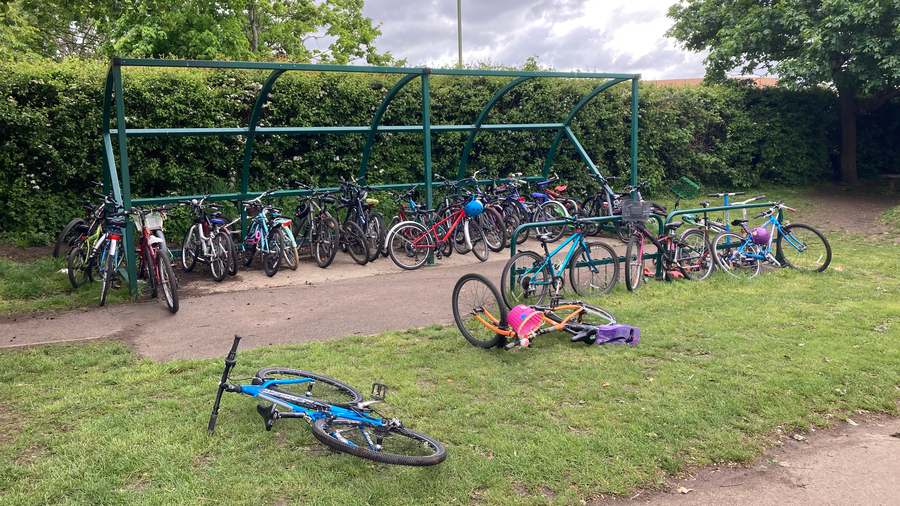 Modal shift in action! Seeing individual children at Larkrise taking up cycling or walking is great, but this photo gives a feel for the broader picture. I did a count and there were twenty bikes more than would fit into the school's cycle parking: this rack was eighteen over capacity and the other was two over! (Normal was fewer cycles than spaces.) And it's still happening: there are still people planning cycle training for their children, trying to buy bikes, and so forth. There are also families who have switched from driving to walking, and increasing numbers of older children being allowed to walk to school by themselves.
Modal shift in action! Seeing individual children at Larkrise taking up cycling or walking is great, but this photo gives a feel for the broader picture. I did a count and there were twenty bikes more than would fit into the school's cycle parking: this rack was eighteen over capacity and the other was two over! (Normal was fewer cycles than spaces.) And it's still happening: there are still people planning cycle training for their children, trying to buy bikes, and so forth. There are also families who have switched from driving to walking, and increasing numbers of older children being allowed to walk to school by themselves.
The driving factor behind this unprecedented cycling boom is that the streets used to get to the school - those in Florence Park most obviously, but also those in Church Cowley/Littlemore - are so much safer with less traffic on them. (Note that this is before the School Streets scheme started — and before the low traffic neighbourhoods are even fully working, since drivers regularly flout the unenforced bus gates.) The school has always encouraged active travel, but their best efforts seem to have achieved little in the face of increasing traffic volumes over the last decades. (Talking to teachers who have been there since it changed from an infants school to a primary, active travel rates may even have declined over that period.)
The biggest remaining barriers to active travel to the school are the main road crossings and junctions. Improvements to the A4158 crossings, and especially the Iffley Rd - Donnington Bridge Rd junction, would help children in the other half of the catchment, in Donnington, Iffley and Rose Hill. These crossings and junctions need to be redesigned to enable safe and direct walking and cycling, rather than to prioritise motor traffic at the expense of everything else. Some kind of protection for getting between Rymer's Lane and Beauchamp Lane would really help. And Howard St not supporting contra-flow cycling is a major barrier to access from the north (though this will be fixed by the East Oxford LTNs).
Yes, walking or cycling to school isn't possible for all the children (though some of the farthest-flung families have surprised me). But if we can get those who can to shift from driving, modal shift at Larkrise alone can potentially replace hundreds of car trips a day (since some school-runs generate four separate trips).

I guess we're going to need a bigger bike rack! A terrific visible example of the impact of LTNs on travel behaviour, among the people where it is most important in setting future behaviour possibilities.